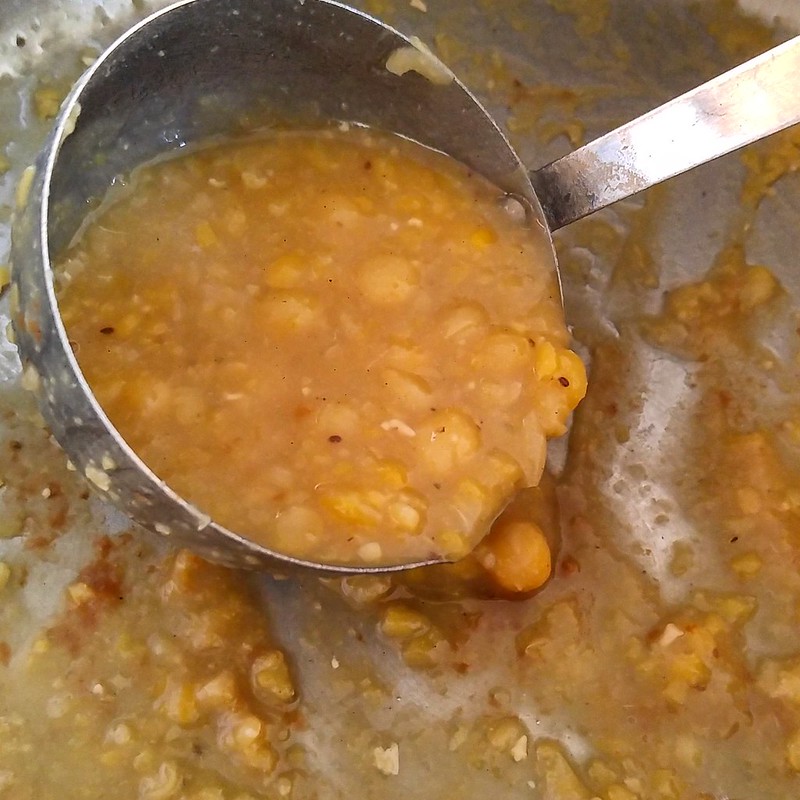Habitant soup and I go way back. In fact, its one of the first soups I ever remember eating - curled up on the couch with a pepper shaker and splitting the whole can of soup with Grandpa. Bowls of it got me though the chicken pox, countless ear infections and flus, even a nasty bout of mononucleosis in highschool, and none of my friends could understand the allure. In fact, my mom's family and I were the only people I knew growing up who would eat it... everyone else's loss, I say. After all, it was essentially soft-cooked, stewed yellow peas in a bowl - old people food.
But for me, it wasn't just peas in a bowl. Something about its buttery flavour (accented perfectly with lashings of black pepper), the soft-yet-textured body and its ability to warm you all the way through and fill you for more than an hour earned the soup a special place in my heart. The French Canadians had it right with this recipe, and somehow the care and love the original cooks back in the 1800s put into their pots translated through time (and cans) to our table.
Sadly, being an old, French Canadian recipe, my beloved yellow cans contain lard - something my digestive system can no longer handle. I had tried other, vegan split pea soups, but the texture was off and flavour lacking. I knew whole peas and simple flavours were the way to go, and after searching for what felt like eons I came on a recipe by a Canadian canning company. I was confident that, having been written by a Canadian, it would be as close to the "real stuff" as possible. I did have to ixnay the pesky ham, though, and I wanted to accent the savoury flavours, so I took a leaf out of Bryanna Clark Grogan’s recipe and added allspice and liquid smoke, plus cumin because I love it.
The key to getting the consistency of silky puree with bits of pea while adding the flavour from the carrot and onion was to add the vegetables "stock style" - leaving them in big chunks and removing them like the bay leaf after they've given up their essential nuances. The tiny bit of liquid smoke nailed the hint of bacony aroma from the original, all while keeping the recipe oil free. The best part was that it made a bunch and canned perfectly in my pressure canner, so I put up a bunch of pints (perfect "for one" size) to enjoy over the winter. I can't wait to make it again - it's pure comfort food.
Speaking of comfort food, our #SundaySupper gang is all about the comforting soup and stews this week. Be sure to check out all the offerings below, and say hi!
Do you have a soup that evokes special memories for you? Let me know in the comments!
Superb Soups
- “Make it Your Own” Soup Bar by The Freshman Cook
- Baked Potato Soup by That Skinny Chick Can Bake
- Cabbage and Kielbasa Soup by Our Good Life
- Chicken and Dumplings by Palatable Pastime
- Easy Homemade Chicken Noodle Soup by Pies and Plots
- Gnocchi, Sausage & Spinach Soup by Bottom Left of the Mitten
- Habitant Pea Soup by What Smells So Good?
- Instant Pot Mexican Chicken and Rice Soup by Sunday Supper Movement
- Meatball and Orzo Soup by Fantastical Sharing of Recipes
Stupendous Soups
- Milchnudeln (German Milk Noodles) by Tara’s Multicultural Table
- Mushroom Fennel Soup by Caroline’s Cooking
- Pasta Fagioli Soup by Soulfully Made
- Slow Cooker Black Bean Chili by Cricket’s Confections
- Crock Pot Chicken Posole by My Imperfect Kitchen
- Slow Cooker Smoky Chicken-Potato Soup by The Weekend Gourmet
- Spicy Lentil Soup with Swiss Chard by Cooking Chat
Habitant Pea Soup
Makes ~11 cups
2 cups dried whole yellow peas
2 cups dried yellow split peas
12 cups water
4 cups vegetable broth
1 large carrot, quartered
1 large onion, quartered
2 cloves minced garlic
½ tsp cumin
½ tsp ground allspice
½ tsp celery seed
salt and freshly-ground black pepper to taste
1 tsp liquid smoke
2 bay leaves
Salt & pepper
- Place whole peas in a bowl and cover with water. Soak overnight, then drain and rinse.
- In a large pot, combine soaked peas with the remaining ingredients
- Bring to a brisk simmer and cook 1 hour, until whole peas are just tender.
- Remove carrot, onion and bay leaf and season with salt and pepper.
- Ladle hot prepared soup into hot quart jars, leaving 1” headspace.
- Process in a pressure canner for 90 minutes at 10 lb pressure. Alternatively, cook 30 minutes longer, then portion and freeze what you don't eat immediately.
- When processing time is complete turn off heat. Allow canner to stand undisturbed until pressure drops to zero.
- Remove jars and cool undisturbed 24 hours.
- Store in a cool, dark place.
Calories: 252.9
Total Fat: 0.8 g
Cholesterol: 0.0 mg
Sodium: 217.5 mg
Total Carbs: 45.0 g
Dietary Fiber: 18.9 g
Protein: 16.2 g


No comments :
Post a Comment
Thanks for the feedback!